Strategic Analysis of the Sri Lankan Tourism Industry: A Report
VerifiedAdded on 2019/09/26
|27
|5525
|615
Report
AI Summary
This report provides a comprehensive analysis of the Sri Lankan tourism industry, examining its growth, competitiveness, and strategic issues. It utilizes Porter's Diamond model to evaluate factor conditions, demand conditions, related and supporting industries, firm strategy, rivalry, and the roles of government and chance. The report highlights both the strengths, such as natural and cultural resources, and weaknesses, like infrastructure and political instability. It also discusses market entry strategies, including Foreign Direct Investment (FDI), weighing the advantages and disadvantages of this approach. The report emphasizes the need for strategic improvements in infrastructure, promotion, and product development to enhance Sri Lanka's competitiveness in the global tourism market, presenting detailed insights and recommendations for sustainable growth and development of the tourism sector. The report draws upon various sources, including economic impact reports and academic publications, to support its findings and recommendations. The report is a valuable resource for students and professionals interested in understanding the dynamics and challenges of the Sri Lankan tourism industry.
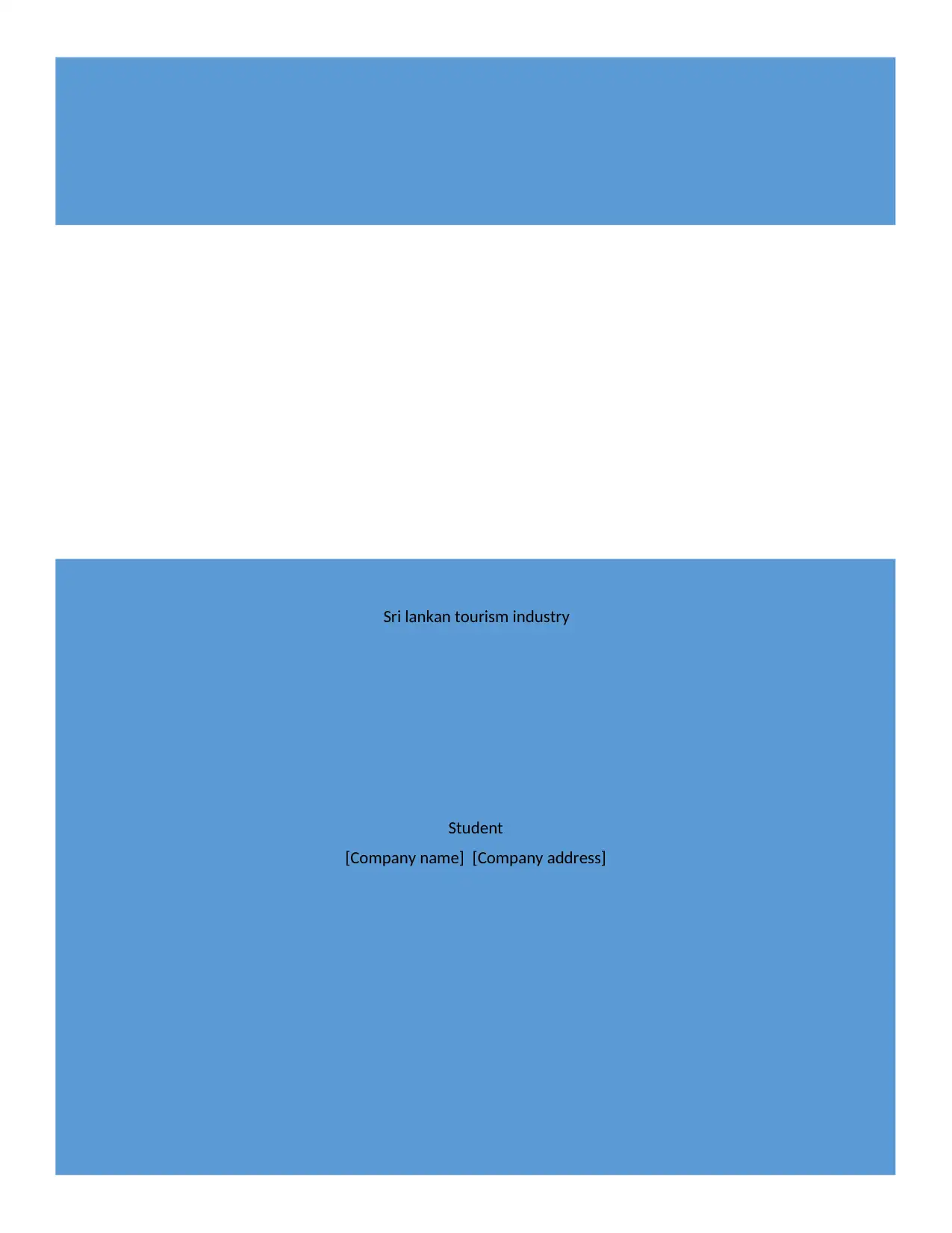
Sri lankan tourism industry
Student
[Company name] [Company address]
Student
[Company name] [Company address]
Paraphrase This Document
Need a fresh take? Get an instant paraphrase of this document with our AI Paraphraser
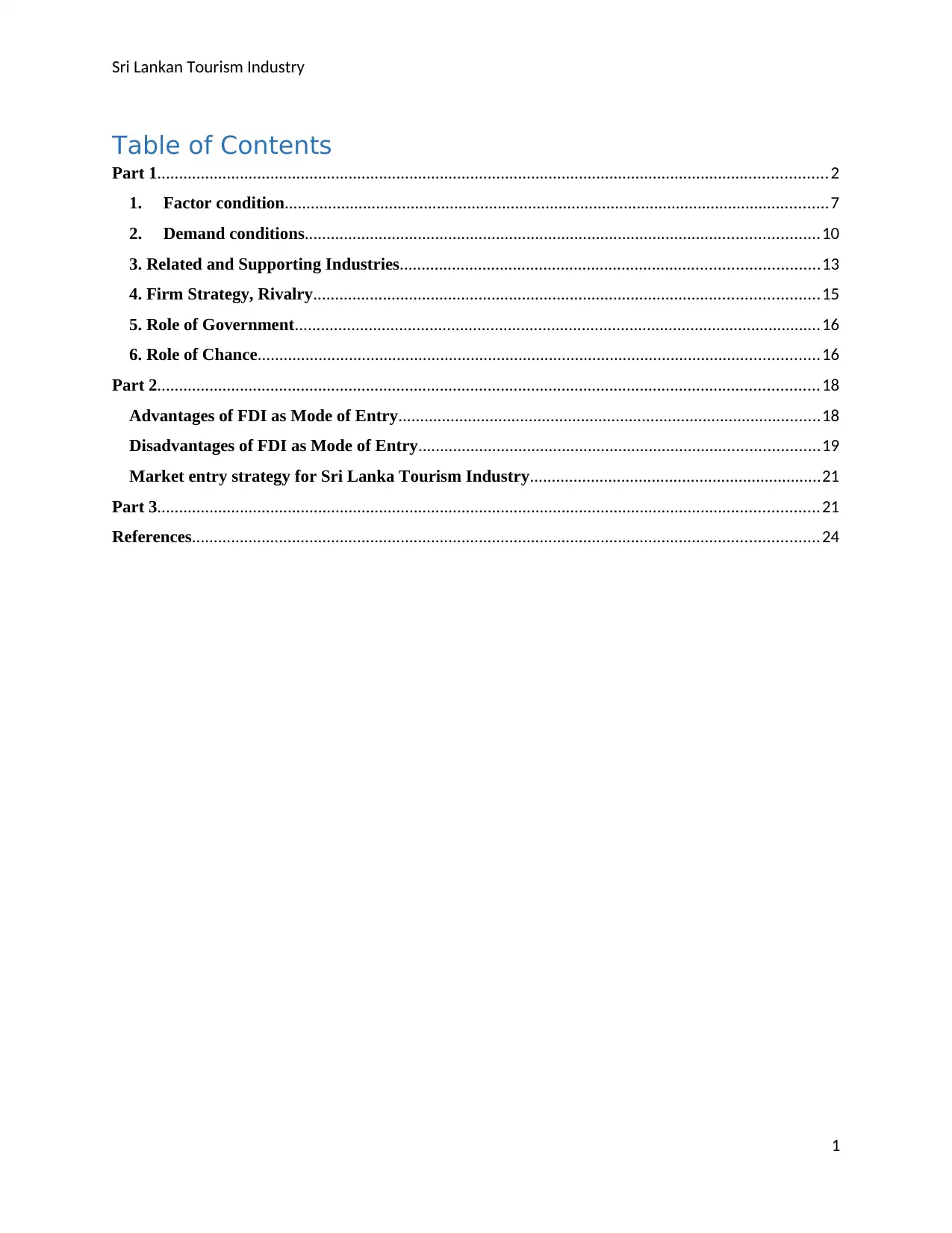
Sri Lankan Tourism Industry
Table of Contents
Part 1..........................................................................................................................................................2
1. Factor condition.............................................................................................................................7
2. Demand conditions......................................................................................................................10
3. Related and Supporting Industries................................................................................................13
4. Firm Strategy, Rivalry....................................................................................................................15
5. Role of Government.........................................................................................................................16
6. Role of Chance.................................................................................................................................16
Part 2........................................................................................................................................................18
Advantages of FDI as Mode of Entry.................................................................................................18
Disadvantages of FDI as Mode of Entry............................................................................................19
Market entry strategy for Sri Lanka Tourism Industry...................................................................21
Part 3........................................................................................................................................................21
References................................................................................................................................................24
1
Table of Contents
Part 1..........................................................................................................................................................2
1. Factor condition.............................................................................................................................7
2. Demand conditions......................................................................................................................10
3. Related and Supporting Industries................................................................................................13
4. Firm Strategy, Rivalry....................................................................................................................15
5. Role of Government.........................................................................................................................16
6. Role of Chance.................................................................................................................................16
Part 2........................................................................................................................................................18
Advantages of FDI as Mode of Entry.................................................................................................18
Disadvantages of FDI as Mode of Entry............................................................................................19
Market entry strategy for Sri Lanka Tourism Industry...................................................................21
Part 3........................................................................................................................................................21
References................................................................................................................................................24
1
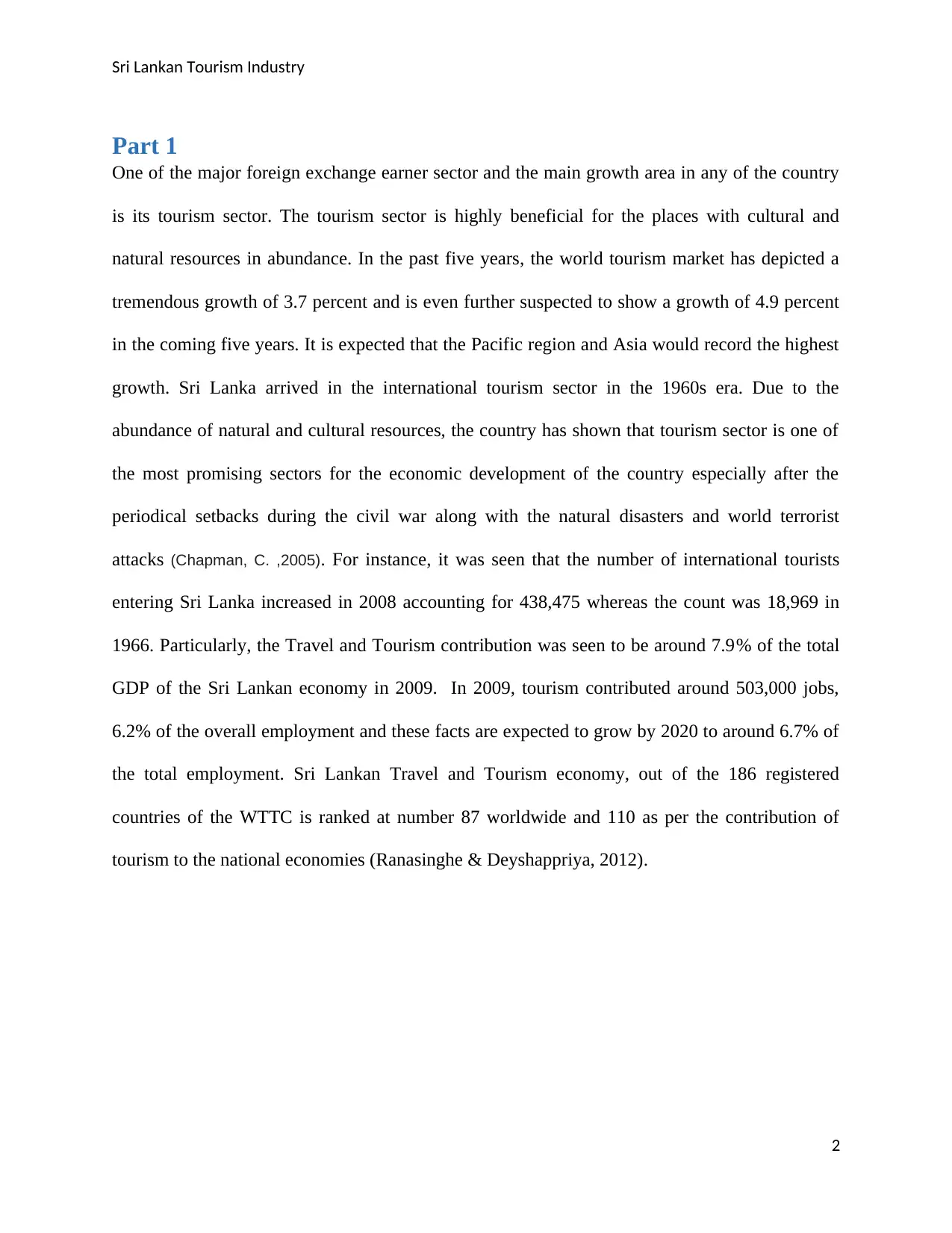
Sri Lankan Tourism Industry
Part 1
One of the major foreign exchange earner sector and the main growth area in any of the country
is its tourism sector. The tourism sector is highly beneficial for the places with cultural and
natural resources in abundance. In the past five years, the world tourism market has depicted a
tremendous growth of 3.7 percent and is even further suspected to show a growth of 4.9 percent
in the coming five years. It is expected that the Pacific region and Asia would record the highest
growth. Sri Lanka arrived in the international tourism sector in the 1960s era. Due to the
abundance of natural and cultural resources, the country has shown that tourism sector is one of
the most promising sectors for the economic development of the country especially after the
periodical setbacks during the civil war along with the natural disasters and world terrorist
attacks (Chapman, C. ,2005). For instance, it was seen that the number of international tourists
entering Sri Lanka increased in 2008 accounting for 438,475 whereas the count was 18,969 in
1966. Particularly, the Travel and Tourism contribution was seen to be around 7.9% of the total
GDP of the Sri Lankan economy in 2009. In 2009, tourism contributed around 503,000 jobs,
6.2% of the overall employment and these facts are expected to grow by 2020 to around 6.7% of
the total employment. Sri Lankan Travel and Tourism economy, out of the 186 registered
countries of the WTTC is ranked at number 87 worldwide and 110 as per the contribution of
tourism to the national economies (Ranasinghe & Deyshappriya, 2012).
2
Part 1
One of the major foreign exchange earner sector and the main growth area in any of the country
is its tourism sector. The tourism sector is highly beneficial for the places with cultural and
natural resources in abundance. In the past five years, the world tourism market has depicted a
tremendous growth of 3.7 percent and is even further suspected to show a growth of 4.9 percent
in the coming five years. It is expected that the Pacific region and Asia would record the highest
growth. Sri Lanka arrived in the international tourism sector in the 1960s era. Due to the
abundance of natural and cultural resources, the country has shown that tourism sector is one of
the most promising sectors for the economic development of the country especially after the
periodical setbacks during the civil war along with the natural disasters and world terrorist
attacks (Chapman, C. ,2005). For instance, it was seen that the number of international tourists
entering Sri Lanka increased in 2008 accounting for 438,475 whereas the count was 18,969 in
1966. Particularly, the Travel and Tourism contribution was seen to be around 7.9% of the total
GDP of the Sri Lankan economy in 2009. In 2009, tourism contributed around 503,000 jobs,
6.2% of the overall employment and these facts are expected to grow by 2020 to around 6.7% of
the total employment. Sri Lankan Travel and Tourism economy, out of the 186 registered
countries of the WTTC is ranked at number 87 worldwide and 110 as per the contribution of
tourism to the national economies (Ranasinghe & Deyshappriya, 2012).
2
⊘ This is a preview!⊘
Do you want full access?
Subscribe today to unlock all pages.

Trusted by 1+ million students worldwide
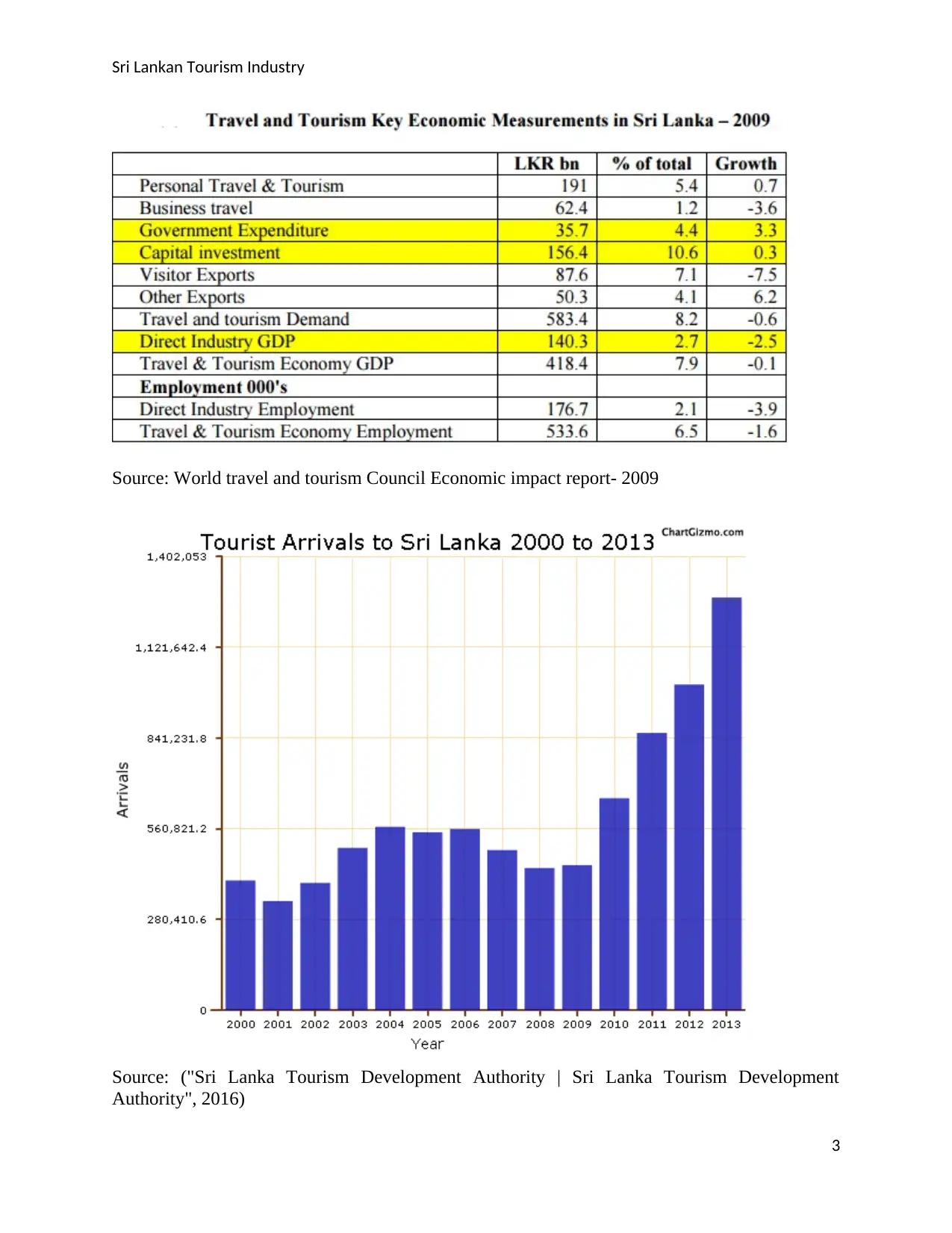
Sri Lankan Tourism Industry
Source: World travel and tourism Council Economic impact report- 2009
Source: ("Sri Lanka Tourism Development Authority | Sri Lanka Tourism Development
Authority", 2016)
3
Source: World travel and tourism Council Economic impact report- 2009
Source: ("Sri Lanka Tourism Development Authority | Sri Lanka Tourism Development
Authority", 2016)
3
Paraphrase This Document
Need a fresh take? Get an instant paraphrase of this document with our AI Paraphraser
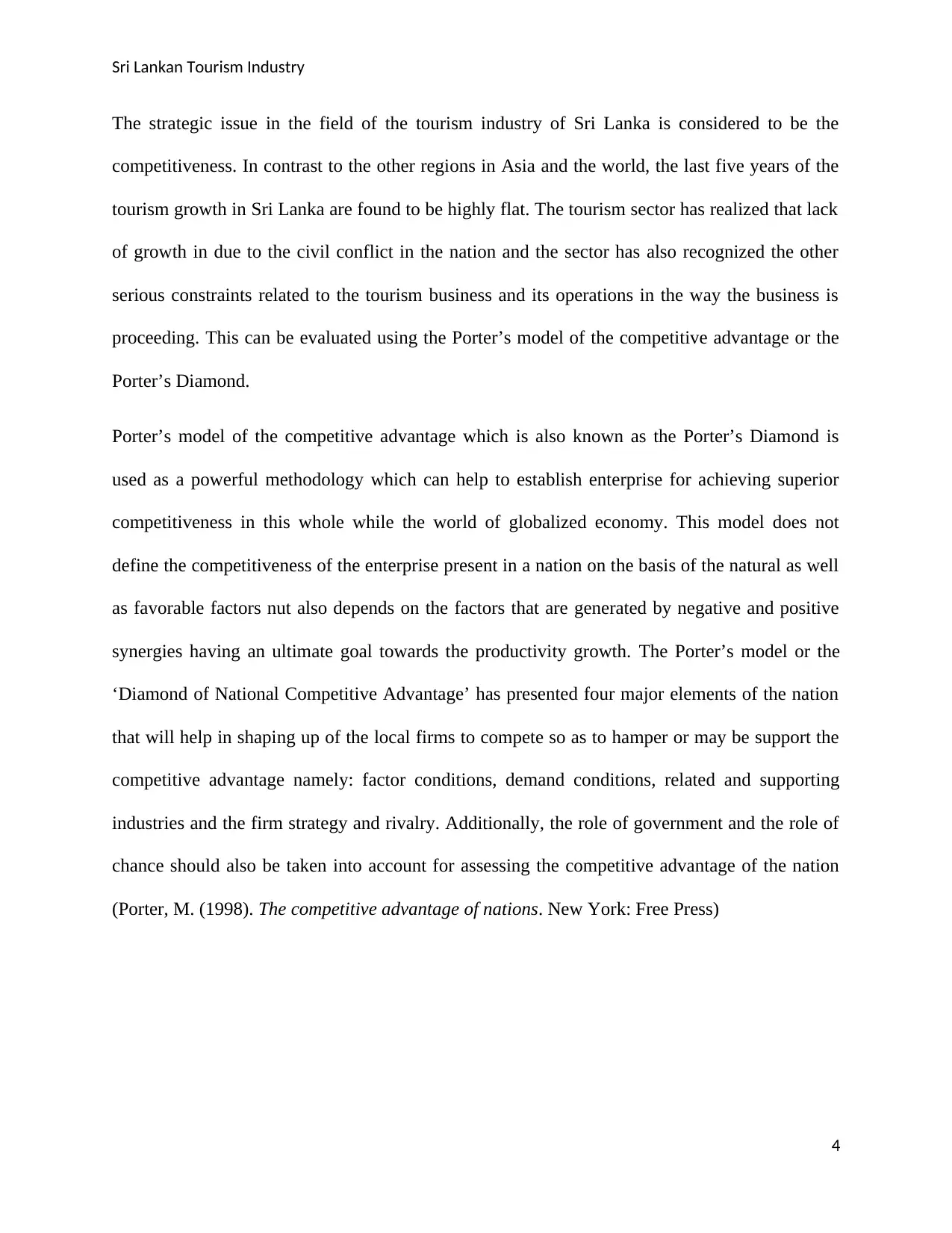
Sri Lankan Tourism Industry
The strategic issue in the field of the tourism industry of Sri Lanka is considered to be the
competitiveness. In contrast to the other regions in Asia and the world, the last five years of the
tourism growth in Sri Lanka are found to be highly flat. The tourism sector has realized that lack
of growth in due to the civil conflict in the nation and the sector has also recognized the other
serious constraints related to the tourism business and its operations in the way the business is
proceeding. This can be evaluated using the Porter’s model of the competitive advantage or the
Porter’s Diamond.
Porter’s model of the competitive advantage which is also known as the Porter’s Diamond is
used as a powerful methodology which can help to establish enterprise for achieving superior
competitiveness in this whole while the world of globalized economy. This model does not
define the competitiveness of the enterprise present in a nation on the basis of the natural as well
as favorable factors nut also depends on the factors that are generated by negative and positive
synergies having an ultimate goal towards the productivity growth. The Porter’s model or the
‘Diamond of National Competitive Advantage’ has presented four major elements of the nation
that will help in shaping up of the local firms to compete so as to hamper or may be support the
competitive advantage namely: factor conditions, demand conditions, related and supporting
industries and the firm strategy and rivalry. Additionally, the role of government and the role of
chance should also be taken into account for assessing the competitive advantage of the nation
(Porter, M. (1998). The competitive advantage of nations. New York: Free Press)
4
The strategic issue in the field of the tourism industry of Sri Lanka is considered to be the
competitiveness. In contrast to the other regions in Asia and the world, the last five years of the
tourism growth in Sri Lanka are found to be highly flat. The tourism sector has realized that lack
of growth in due to the civil conflict in the nation and the sector has also recognized the other
serious constraints related to the tourism business and its operations in the way the business is
proceeding. This can be evaluated using the Porter’s model of the competitive advantage or the
Porter’s Diamond.
Porter’s model of the competitive advantage which is also known as the Porter’s Diamond is
used as a powerful methodology which can help to establish enterprise for achieving superior
competitiveness in this whole while the world of globalized economy. This model does not
define the competitiveness of the enterprise present in a nation on the basis of the natural as well
as favorable factors nut also depends on the factors that are generated by negative and positive
synergies having an ultimate goal towards the productivity growth. The Porter’s model or the
‘Diamond of National Competitive Advantage’ has presented four major elements of the nation
that will help in shaping up of the local firms to compete so as to hamper or may be support the
competitive advantage namely: factor conditions, demand conditions, related and supporting
industries and the firm strategy and rivalry. Additionally, the role of government and the role of
chance should also be taken into account for assessing the competitive advantage of the nation
(Porter, M. (1998). The competitive advantage of nations. New York: Free Press)
4
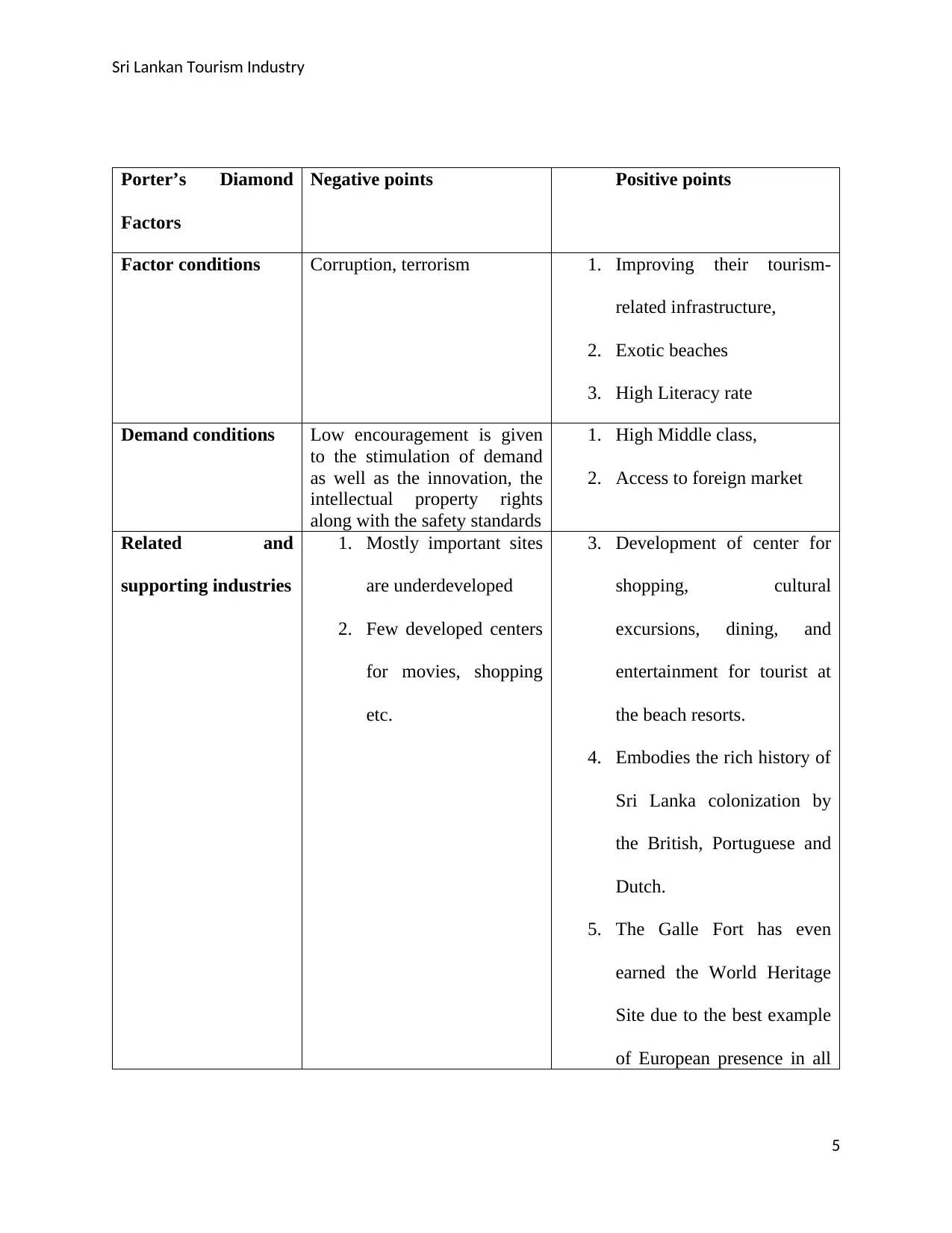
Sri Lankan Tourism Industry
Porter’s Diamond
Factors
Negative points Positive points
Factor conditions Corruption, terrorism 1. Improving their tourism-
related infrastructure,
2. Exotic beaches
3. High Literacy rate
Demand conditions Low encouragement is given
to the stimulation of demand
as well as the innovation, the
intellectual property rights
along with the safety standards
1. High Middle class,
2. Access to foreign market
Related and
supporting industries
1. Mostly important sites
are underdeveloped
2. Few developed centers
for movies, shopping
etc.
3. Development of center for
shopping, cultural
excursions, dining, and
entertainment for tourist at
the beach resorts.
4. Embodies the rich history of
Sri Lanka colonization by
the British, Portuguese and
Dutch.
5. The Galle Fort has even
earned the World Heritage
Site due to the best example
of European presence in all
5
Porter’s Diamond
Factors
Negative points Positive points
Factor conditions Corruption, terrorism 1. Improving their tourism-
related infrastructure,
2. Exotic beaches
3. High Literacy rate
Demand conditions Low encouragement is given
to the stimulation of demand
as well as the innovation, the
intellectual property rights
along with the safety standards
1. High Middle class,
2. Access to foreign market
Related and
supporting industries
1. Mostly important sites
are underdeveloped
2. Few developed centers
for movies, shopping
etc.
3. Development of center for
shopping, cultural
excursions, dining, and
entertainment for tourist at
the beach resorts.
4. Embodies the rich history of
Sri Lanka colonization by
the British, Portuguese and
Dutch.
5. The Galle Fort has even
earned the World Heritage
Site due to the best example
of European presence in all
5
⊘ This is a preview!⊘
Do you want full access?
Subscribe today to unlock all pages.

Trusted by 1+ million students worldwide
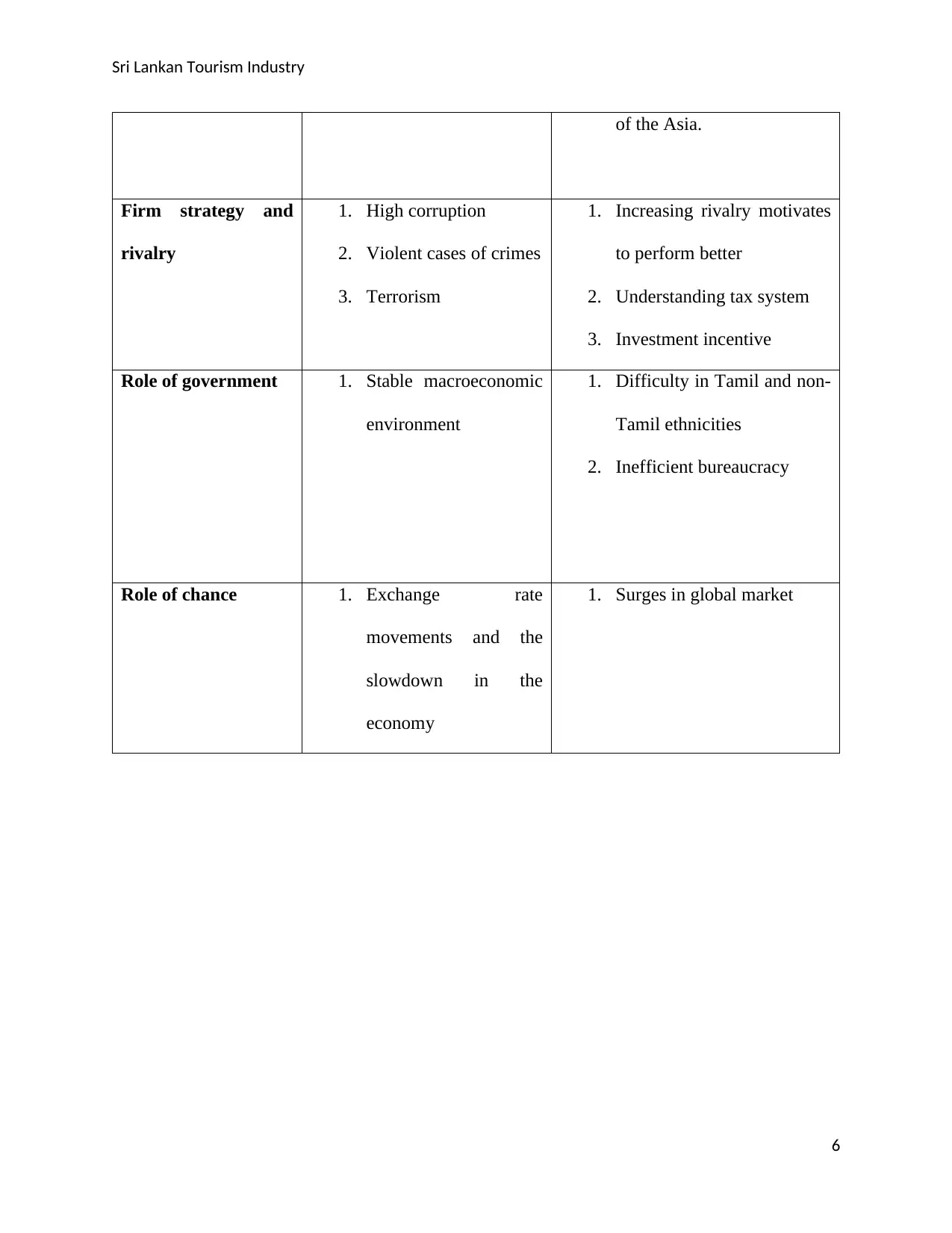
Sri Lankan Tourism Industry
of the Asia.
Firm strategy and
rivalry
1. High corruption
2. Violent cases of crimes
3. Terrorism
1. Increasing rivalry motivates
to perform better
2. Understanding tax system
3. Investment incentive
Role of government 1. Stable macroeconomic
environment
1. Difficulty in Tamil and non-
Tamil ethnicities
2. Inefficient bureaucracy
Role of chance 1. Exchange rate
movements and the
slowdown in the
economy
1. Surges in global market
6
of the Asia.
Firm strategy and
rivalry
1. High corruption
2. Violent cases of crimes
3. Terrorism
1. Increasing rivalry motivates
to perform better
2. Understanding tax system
3. Investment incentive
Role of government 1. Stable macroeconomic
environment
1. Difficulty in Tamil and non-
Tamil ethnicities
2. Inefficient bureaucracy
Role of chance 1. Exchange rate
movements and the
slowdown in the
economy
1. Surges in global market
6
Paraphrase This Document
Need a fresh take? Get an instant paraphrase of this document with our AI Paraphraser
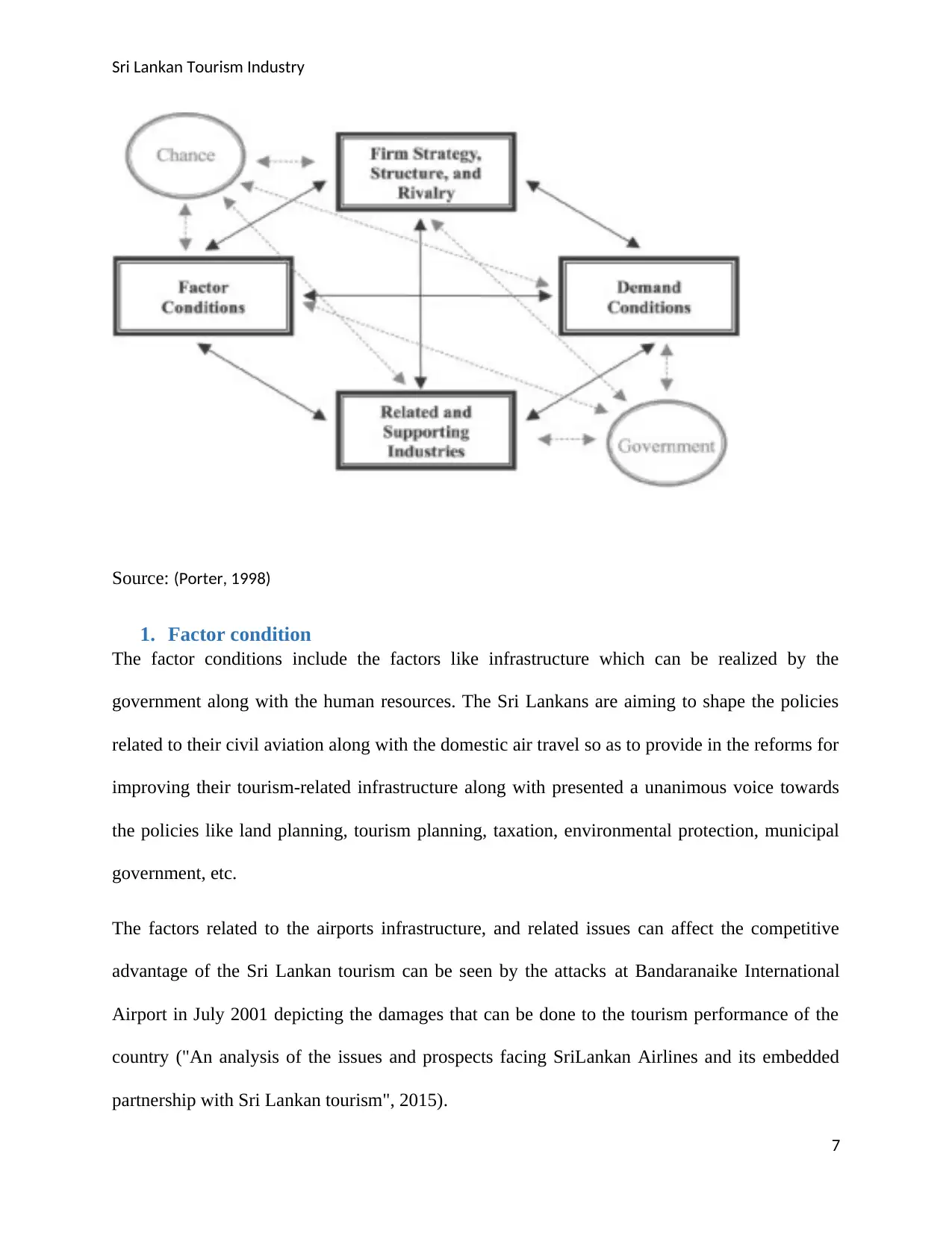
Sri Lankan Tourism Industry
Source: (Porter, 1998)
1. Factor condition
The factor conditions include the factors like infrastructure which can be realized by the
government along with the human resources. The Sri Lankans are aiming to shape the policies
related to their civil aviation along with the domestic air travel so as to provide in the reforms for
improving their tourism-related infrastructure along with presented a unanimous voice towards
the policies like land planning, tourism planning, taxation, environmental protection, municipal
government, etc.
The factors related to the airports infrastructure, and related issues can affect the competitive
advantage of the Sri Lankan tourism can be seen by the attacks at Bandaranaike International
Airport in July 2001 depicting the damages that can be done to the tourism performance of the
country ("An analysis of the issues and prospects facing SriLankan Airlines and its embedded
partnership with Sri Lankan tourism", 2015).
7
Source: (Porter, 1998)
1. Factor condition
The factor conditions include the factors like infrastructure which can be realized by the
government along with the human resources. The Sri Lankans are aiming to shape the policies
related to their civil aviation along with the domestic air travel so as to provide in the reforms for
improving their tourism-related infrastructure along with presented a unanimous voice towards
the policies like land planning, tourism planning, taxation, environmental protection, municipal
government, etc.
The factors related to the airports infrastructure, and related issues can affect the competitive
advantage of the Sri Lankan tourism can be seen by the attacks at Bandaranaike International
Airport in July 2001 depicting the damages that can be done to the tourism performance of the
country ("An analysis of the issues and prospects facing SriLankan Airlines and its embedded
partnership with Sri Lankan tourism", 2015).
7
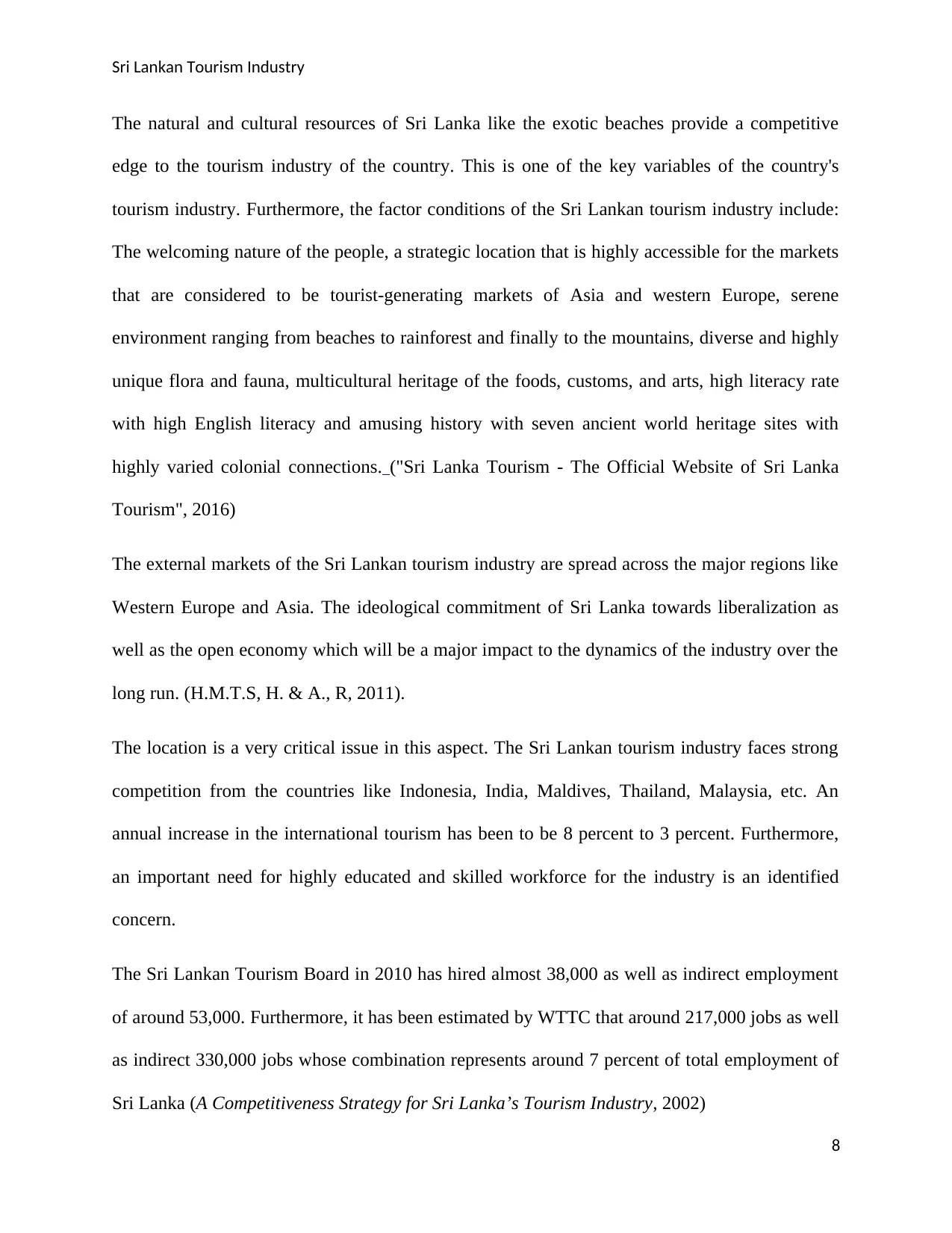
Sri Lankan Tourism Industry
The natural and cultural resources of Sri Lanka like the exotic beaches provide a competitive
edge to the tourism industry of the country. This is one of the key variables of the country's
tourism industry. Furthermore, the factor conditions of the Sri Lankan tourism industry include:
The welcoming nature of the people, a strategic location that is highly accessible for the markets
that are considered to be tourist-generating markets of Asia and western Europe, serene
environment ranging from beaches to rainforest and finally to the mountains, diverse and highly
unique flora and fauna, multicultural heritage of the foods, customs, and arts, high literacy rate
with high English literacy and amusing history with seven ancient world heritage sites with
highly varied colonial connections. ("Sri Lanka Tourism - The Official Website of Sri Lanka
Tourism", 2016)
The external markets of the Sri Lankan tourism industry are spread across the major regions like
Western Europe and Asia. The ideological commitment of Sri Lanka towards liberalization as
well as the open economy which will be a major impact to the dynamics of the industry over the
long run. (H.M.T.S, H. & A., R, 2011).
The location is a very critical issue in this aspect. The Sri Lankan tourism industry faces strong
competition from the countries like Indonesia, India, Maldives, Thailand, Malaysia, etc. An
annual increase in the international tourism has been to be 8 percent to 3 percent. Furthermore,
an important need for highly educated and skilled workforce for the industry is an identified
concern.
The Sri Lankan Tourism Board in 2010 has hired almost 38,000 as well as indirect employment
of around 53,000. Furthermore, it has been estimated by WTTC that around 217,000 jobs as well
as indirect 330,000 jobs whose combination represents around 7 percent of total employment of
Sri Lanka (A Competitiveness Strategy for Sri Lanka’s Tourism Industry, 2002)
8
The natural and cultural resources of Sri Lanka like the exotic beaches provide a competitive
edge to the tourism industry of the country. This is one of the key variables of the country's
tourism industry. Furthermore, the factor conditions of the Sri Lankan tourism industry include:
The welcoming nature of the people, a strategic location that is highly accessible for the markets
that are considered to be tourist-generating markets of Asia and western Europe, serene
environment ranging from beaches to rainforest and finally to the mountains, diverse and highly
unique flora and fauna, multicultural heritage of the foods, customs, and arts, high literacy rate
with high English literacy and amusing history with seven ancient world heritage sites with
highly varied colonial connections. ("Sri Lanka Tourism - The Official Website of Sri Lanka
Tourism", 2016)
The external markets of the Sri Lankan tourism industry are spread across the major regions like
Western Europe and Asia. The ideological commitment of Sri Lanka towards liberalization as
well as the open economy which will be a major impact to the dynamics of the industry over the
long run. (H.M.T.S, H. & A., R, 2011).
The location is a very critical issue in this aspect. The Sri Lankan tourism industry faces strong
competition from the countries like Indonesia, India, Maldives, Thailand, Malaysia, etc. An
annual increase in the international tourism has been to be 8 percent to 3 percent. Furthermore,
an important need for highly educated and skilled workforce for the industry is an identified
concern.
The Sri Lankan Tourism Board in 2010 has hired almost 38,000 as well as indirect employment
of around 53,000. Furthermore, it has been estimated by WTTC that around 217,000 jobs as well
as indirect 330,000 jobs whose combination represents around 7 percent of total employment of
Sri Lanka (A Competitiveness Strategy for Sri Lanka’s Tourism Industry, 2002)
8
⊘ This is a preview!⊘
Do you want full access?
Subscribe today to unlock all pages.

Trusted by 1+ million students worldwide
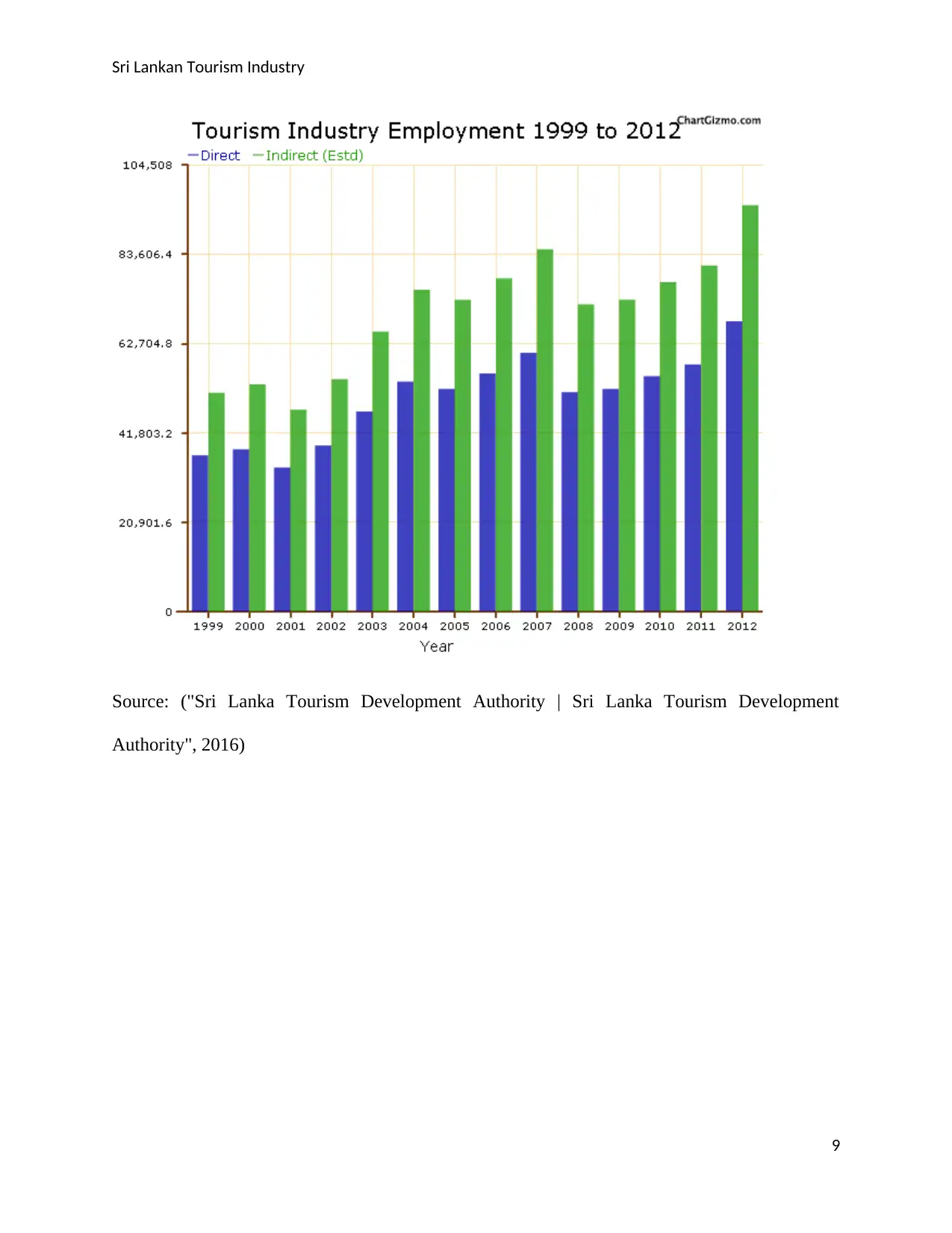
Sri Lankan Tourism Industry
Source: ("Sri Lanka Tourism Development Authority | Sri Lanka Tourism Development
Authority", 2016)
9
Source: ("Sri Lanka Tourism Development Authority | Sri Lanka Tourism Development
Authority", 2016)
9
Paraphrase This Document
Need a fresh take? Get an instant paraphrase of this document with our AI Paraphraser
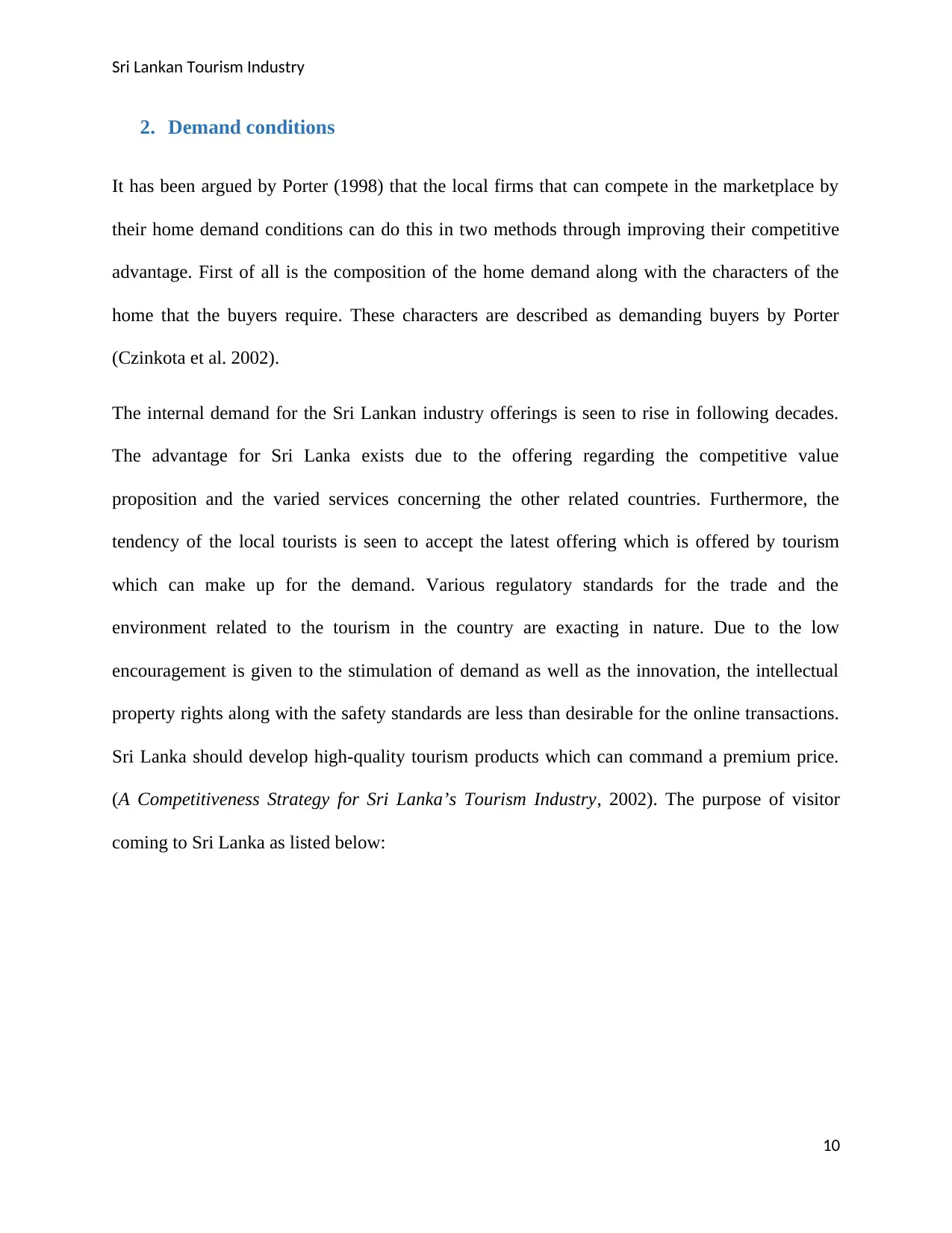
Sri Lankan Tourism Industry
2. Demand conditions
It has been argued by Porter (1998) that the local firms that can compete in the marketplace by
their home demand conditions can do this in two methods through improving their competitive
advantage. First of all is the composition of the home demand along with the characters of the
home that the buyers require. These characters are described as demanding buyers by Porter
(Czinkota et al. 2002).
The internal demand for the Sri Lankan industry offerings is seen to rise in following decades.
The advantage for Sri Lanka exists due to the offering regarding the competitive value
proposition and the varied services concerning the other related countries. Furthermore, the
tendency of the local tourists is seen to accept the latest offering which is offered by tourism
which can make up for the demand. Various regulatory standards for the trade and the
environment related to the tourism in the country are exacting in nature. Due to the low
encouragement is given to the stimulation of demand as well as the innovation, the intellectual
property rights along with the safety standards are less than desirable for the online transactions.
Sri Lanka should develop high-quality tourism products which can command a premium price.
(A Competitiveness Strategy for Sri Lanka’s Tourism Industry, 2002). The purpose of visitor
coming to Sri Lanka as listed below:
10
2. Demand conditions
It has been argued by Porter (1998) that the local firms that can compete in the marketplace by
their home demand conditions can do this in two methods through improving their competitive
advantage. First of all is the composition of the home demand along with the characters of the
home that the buyers require. These characters are described as demanding buyers by Porter
(Czinkota et al. 2002).
The internal demand for the Sri Lankan industry offerings is seen to rise in following decades.
The advantage for Sri Lanka exists due to the offering regarding the competitive value
proposition and the varied services concerning the other related countries. Furthermore, the
tendency of the local tourists is seen to accept the latest offering which is offered by tourism
which can make up for the demand. Various regulatory standards for the trade and the
environment related to the tourism in the country are exacting in nature. Due to the low
encouragement is given to the stimulation of demand as well as the innovation, the intellectual
property rights along with the safety standards are less than desirable for the online transactions.
Sri Lanka should develop high-quality tourism products which can command a premium price.
(A Competitiveness Strategy for Sri Lanka’s Tourism Industry, 2002). The purpose of visitor
coming to Sri Lanka as listed below:
10
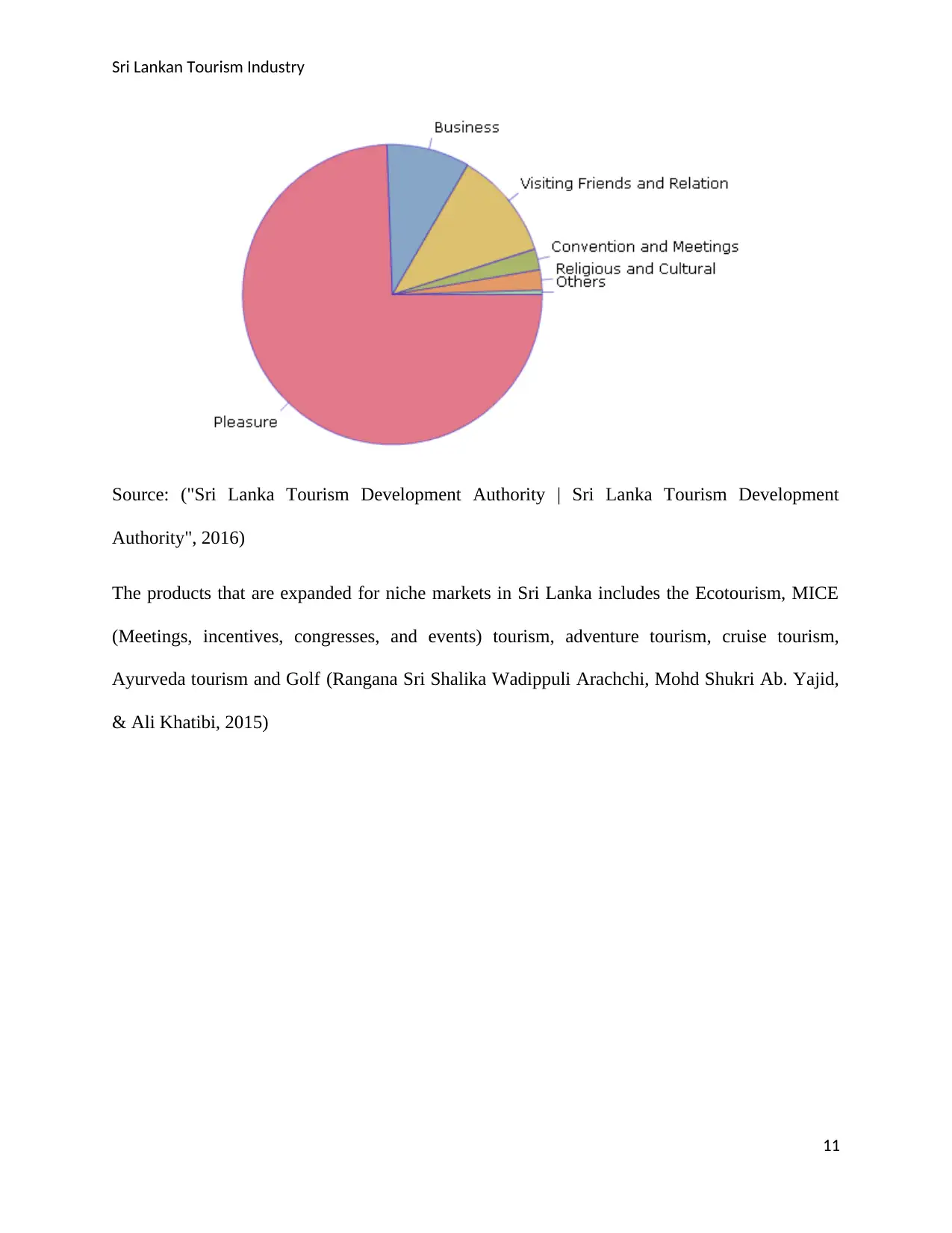
Sri Lankan Tourism Industry
Source: ("Sri Lanka Tourism Development Authority | Sri Lanka Tourism Development
Authority", 2016)
The products that are expanded for niche markets in Sri Lanka includes the Ecotourism, MICE
(Meetings, incentives, congresses, and events) tourism, adventure tourism, cruise tourism,
Ayurveda tourism and Golf (Rangana Sri Shalika Wadippuli Arachchi, Mohd Shukri Ab. Yajid,
& Ali Khatibi, 2015)
11
Source: ("Sri Lanka Tourism Development Authority | Sri Lanka Tourism Development
Authority", 2016)
The products that are expanded for niche markets in Sri Lanka includes the Ecotourism, MICE
(Meetings, incentives, congresses, and events) tourism, adventure tourism, cruise tourism,
Ayurveda tourism and Golf (Rangana Sri Shalika Wadippuli Arachchi, Mohd Shukri Ab. Yajid,
& Ali Khatibi, 2015)
11
⊘ This is a preview!⊘
Do you want full access?
Subscribe today to unlock all pages.

Trusted by 1+ million students worldwide
1 out of 27
Related Documents
Your All-in-One AI-Powered Toolkit for Academic Success.
+13062052269
info@desklib.com
Available 24*7 on WhatsApp / Email
![[object Object]](/_next/static/media/star-bottom.7253800d.svg)
Unlock your academic potential
Copyright © 2020–2025 A2Z Services. All Rights Reserved. Developed and managed by ZUCOL.





